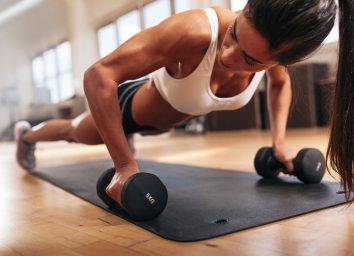Doing This One Thing While Strength Training Burns Twice As Many Calories, Science Says

Many people just beginning their fitness journey toward a lean, toned physique make the mistake of focusing solely on cardio and aerobics. Exercises like jogging, walking, and cycling are no doubt a major ingredient while cooking up a leaner look, but failing to add in some weightlifting is like serving a PB&J sandwich without the jelly. It just isn't going to work!
Indeed, if you still mistakenly believe the weight room is only for seasoned athletes or bodybuilders, you're sabotaging your lean body goals right from the start. "You may lose weight faster doing cardio only, but unfortunately it's the wrong kind of weight," Greg Justice, PT, told Women's Health. "Weight training builds lean muscle mass, which elevates your metabolism and burns more fat, even when you're not exercising."
Moreover, this study published in the International Journal of Sport Nutrition and Exercise Metabolism concludes that combining a clean diet with strength training is effective at simultaneously burning unneeded fat while preserving muscle mass. So, it's quite clear that strength training, in general, is helpful for weight loss. That being said, making one relatively minor adjustment to your weightlifting routine can potentially help you burn twice as many calories.
Read on to learn more, and then, don't miss This Workout Plan Will Keep You Lean Throughout the Holidays.
Prioritize more reps over heavy weight

It can be tempting to lift the heaviest weights you can handle, but science tells us that choosing to prioritize rep quantity over heavy weights helps burn significantly more calories.
This study released in the Journal of Strength and Conditioning Research tracked calories burned as a group of young men either performed lots of bench press reps with low weight or performed a much heavier bench press for just a few repetitions. Incredibly, subjects who performed more reps with lighter weights ended up burning close to double the calories as the others.
"What type of lifting 'burns' the most calories, muscular endurance (high reps), or strength-type training (heavy weight)? The answer appears to be muscular endurance-type exercise," the study concludes.
Another study published in Diabetes Care came to similar conclusions, discovering that those who performed just a few reps with heavy weights burned far fewer calories than others who performed more reps with lighter weights.
These findings shouldn't serve as an excuse to take it easy while working out. Your strength training sessions should still be strenuous. Instead of lifting the heaviest weights you can only handle for 1-5 reps at a time, go for lighter barbells in 15-25 rep increments. Your muscles should still be burning and exhausted afterward, but all of the extra energy used performing more reps will translate into extra calories burned.
Related: This Workout Is Three Times Better for Your Health Than Walking, New Study Says.
You'll still build strength

If you're worried that lifting lighter weights will sabotage your big bicep dreams, put your mind at ease. Science tells us that a high-rep approach to weightlifting can build muscle and strength just as well as heavier weights and low reps.
Research published in the Journal of Applied Physiology tracked a group of experienced weightlifters as they either lifted heavy weights at low reps or performed more reps with lighter weights. After 12 weeks had passed the research team assessed both muscle mass and muscle fiber size. Gains were virtually identical between the two experimental cohorts.
The unifying factor here was that all the participants, regardless of reps or weight, lifted to the point of muscle failure. So, again, as long as you put serious effort into your workout and lift until your muscles are exhausted, choosing light weights and high reps will help build strength just as much as any other weightlifting approach. And you'll burn more calories!
"Fatigue is the great equalizer here," says senior study author Stuart Phillips, professor in the Department of Kinesiology at McMaster University. "Lift to the point of exhaustion and it doesn't matter whether the weights are heavy or light."
Related: Sign up for our newsletter for the latest health and fitness news!
You'll have a lower risk of injury

Another advantage to a light weight, high rep approach to strength training is reduced risk of injury. It doesn't take much imagination to envision what can go wrong while lifting heavy weights. The stakes are much higher, as a simple slip of the hand or improper form can result in serious injury. Lighter weights are also easier on the joints, and lots of reps can help strengthen connective tissues.
"Working with light weights allows you to perform movements through your full range of motion properly and precisely," Ashley Verma, founder of boutique barre studio Define.London, told INSIDER. "Plus, the risk of injury is much lower… As we age, we can develop joint problems and this can also be exacerbated by the wrong kind of training. Using lighter weights and incorporating longer reps will only empower the body, not hit it abruptly."
Related: Secret Effects of Lifting Weights Just Once Per Week, Science Says
Bonus: Compound exercises burn more calories too

Another great way to burn more calories while building muscle is to choose compound exercises over isolation exercises. A compound exercise, such as a lat pulldown or squat, simultaneously works out multiple muscle groups. Meanwhile, isolation exercises like bicep curls only target one muscle individually.
"The higher your metabolism, the more calories you burn," explains 19-time World Champion powerlifter Robert Herbst. "The best is weightlifting exercises that involve compound movements such as squats, lunges, bench press, and deadlifts that work the major muscle groups. These exercises keep the metabolism elevated for 48 to 72 hours afterward as the body repairs muscle that was broken down and builds new muscle."
For more, check out This 5-Move At-Home Workout Will Help You Build Strength.








